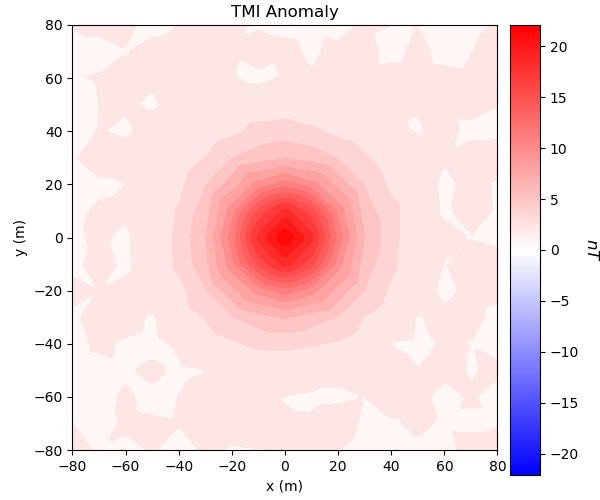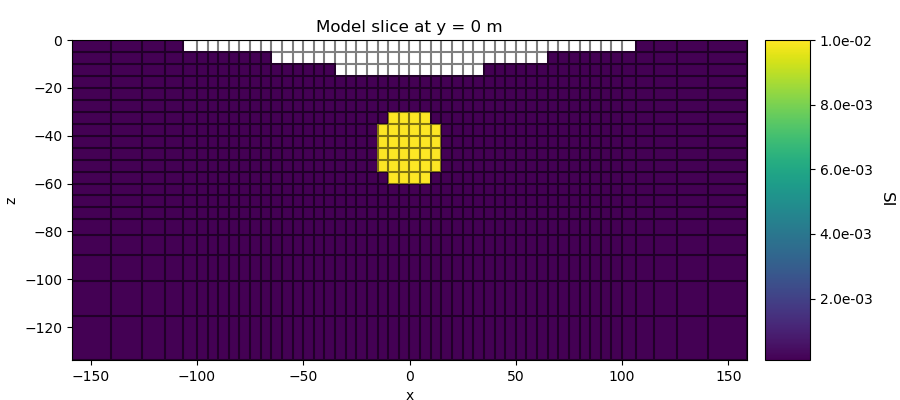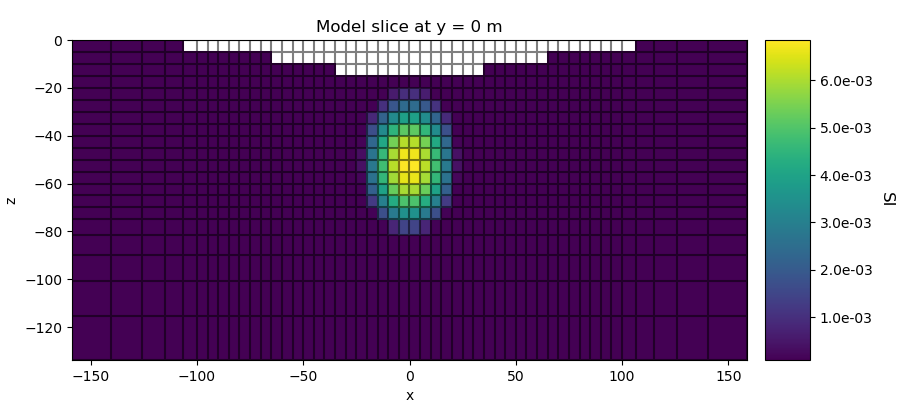Note
Click here to download the full example code
Sparse Norm Inversion for Total Magnetic Intensity Data on a Tensor Mesh¶
Here we invert total magnetic intensity (TMI) data to recover a magnetic susceptibility model. We formulate the inverse problem as an iteratively re-weighted least-squares (IRLS) optimization problem. For this tutorial, we focus on the following:
Defining the survey from xyz formatted data
Generating a mesh based on survey geometry
Including surface topography
Defining the inverse problem (data misfit, regularization, optimization)
Specifying directives for the inversion
Setting sparse and blocky norms
Plotting the recovered model and data misfit
Although we consider TMI data in this tutorial, the same approach can be used to invert other types of geophysical data.
Import modules¶
import os
import numpy as np
import matplotlib as mpl
import matplotlib.pyplot as plt
import tarfile
from discretize import TensorMesh
from SimPEG.potential_fields import magnetics
from SimPEG.utils import plot2Ddata, surface2ind_topo
from SimPEG import (
maps,
data,
inverse_problem,
data_misfit,
regularization,
optimization,
directives,
inversion,
utils,
)
# sphinx_gallery_thumbnail_number = 3
Load Data and Plot¶
File paths for assets we are loading. To set up the inversion, we require topography and field observations. The true model defined on the whole mesh is loaded to compare with the inversion result. These files are stored as a tar-file on our google cloud bucket: “https://storage.googleapis.com/simpeg/doc-assets/magnetics.tar.gz”
# storage bucket where we have the data
data_source = "https://storage.googleapis.com/simpeg/doc-assets/magnetics.tar.gz"
# download the data
downloaded_data = utils.download(data_source, overwrite=True)
# unzip the tarfile
tar = tarfile.open(downloaded_data, "r")
tar.extractall()
tar.close()
# path to the directory containing our data
dir_path = downloaded_data.split(".")[0] + os.path.sep
# files to work with
topo_filename = dir_path + "magnetics_topo.txt"
data_filename = dir_path + "magnetics_data.obs"
model_filename = dir_path + "true_model.txt"
Out:
overwriting /Users/josephcapriotti/codes/simpeg/tutorials/04-magnetics/magnetics.tar.gz
Downloading https://storage.googleapis.com/simpeg/doc-assets/magnetics.tar.gz
saved to: /Users/josephcapriotti/codes/simpeg/tutorials/04-magnetics/magnetics.tar.gz
Download completed!
Load Data and Plot¶
Here we load and plot synthetic TMI data. Topography is generally defined as an (N, 3) array. TMI data is generally defined with 4 columns: x, y, z and data.
xyz_topo = np.loadtxt(str(topo_filename))
dobs = np.loadtxt(str(data_filename))
receiver_locations = dobs[:, 0:3]
dobs = dobs[:, -1]
# Plot
fig = plt.figure(figsize=(6, 5))
v_max = np.max(np.abs(dobs))
ax1 = fig.add_axes([0.1, 0.1, 0.75, 0.85])
plot2Ddata(
receiver_locations,
dobs,
ax=ax1,
ncontour=30,
clim=(-v_max, v_max),
contourOpts={"cmap": "bwr"},
)
ax1.set_title("TMI Anomaly")
ax1.set_xlabel("x (m)")
ax1.set_ylabel("y (m)")
ax2 = fig.add_axes([0.85, 0.05, 0.05, 0.9])
norm = mpl.colors.Normalize(vmin=-np.max(np.abs(dobs)), vmax=np.max(np.abs(dobs)))
cbar = mpl.colorbar.ColorbarBase(
ax2, norm=norm, orientation="vertical", cmap=mpl.cm.bwr
)
cbar.set_label("$nT$", rotation=270, labelpad=15, size=12)
plt.show()

Out:
/Users/josephcapriotti/codes/simpeg/tutorials/04-magnetics/plot_inv_2a_magnetics_induced.py:123: UserWarning: Matplotlib is currently using agg, which is a non-GUI backend, so cannot show the figure.
plt.show()
Assign Uncertainty¶
Inversion with SimPEG requires that we define standard deviation on our data. This represents our estimate of the noise in our data. For magnetic inversions, a constant floor value is generall applied to all data. For this tutorial, the standard deviation on each datum will be 2% of the maximum observed magnetics anomaly value.
Defining the Survey¶
Here, we define survey that will be used for the simulation. Magnetic surveys are simple to create. The user only needs an (N, 3) array to define the xyz locations of the observation locations, the list of field components which are to be modeled and the properties of the Earth’s field.
# Define the component(s) of the field we are inverting as a list. Here we will
# invert total magnetic intensity data.
components = ["tmi"]
# Use the observation locations and components to define the receivers. To
# simulate data, the receivers must be defined as a list.
receiver_list = magnetics.receivers.Point(receiver_locations, components=components)
receiver_list = [receiver_list]
# Define the inducing field H0 = (intensity [nT], inclination [deg], declination [deg])
inclination = 90
declination = 0
strength = 50000
inducing_field = (strength, inclination, declination)
source_field = magnetics.sources.SourceField(
receiver_list=receiver_list, parameters=inducing_field
)
# Define the survey
survey = magnetics.survey.Survey(source_field)
Defining the Data¶
Here is where we define the data that is inverted. The data is defined by the survey, the observation values and the standard deviations.
Defining a Tensor Mesh¶
Here, we create the tensor mesh that will be used to invert TMI data. If desired, we could define an OcTree mesh.
Starting/Reference Model and Mapping on Tensor Mesh¶
Here, we would create starting and/or reference models for the inversion as well as the mapping from the model space to the active cells. Starting and reference models can be a constant background value or contain a-priori structures. Here, the background is 1e-4 SI.
# Define background susceptibility model in SI. Don't make this 0!
# Otherwise the gradient for the 1st iteration is zero and the inversion will
# not converge.
background_susceptibility = 1e-4
# Find the indecies of the active cells in forward model (ones below surface)
ind_active = surface2ind_topo(mesh, xyz_topo)
# Define mapping from model to active cells
nC = int(ind_active.sum())
model_map = maps.IdentityMap(nP=nC) # model consists of a value for each cell
# Define starting model
starting_model = background_susceptibility * np.ones(nC)
Define the Physics¶
Here, we define the physics of the magnetics problem by using the simulation class.
# Define the problem. Define the cells below topography and the mapping
simulation = magnetics.simulation.Simulation3DIntegral(
survey=survey,
mesh=mesh,
modelType="susceptibility",
chiMap=model_map,
actInd=ind_active,
)
Define Inverse Problem¶
The inverse problem is defined by 3 things:
Data Misfit: a measure of how well our recovered model explains the field data
Regularization: constraints placed on the recovered model and a priori information
Optimization: the numerical approach used to solve the inverse problem
# Define the data misfit. Here the data misfit is the L2 norm of the weighted
# residual between the observed data and the data predicted for a given model.
# Within the data misfit, the residual between predicted and observed data are
# normalized by the data's standard deviation.
dmis = data_misfit.L2DataMisfit(data=data_object, simulation=simulation)
# Define the regularization (model objective function)
reg = regularization.Sparse(
mesh,
indActive=ind_active,
mapping=model_map,
mref=starting_model,
gradientType="total",
alpha_s=1,
alpha_x=1,
alpha_y=1,
alpha_z=1,
)
# Define sparse and blocky norms p, qx, qy, qz
reg.norms = np.c_[0, 2, 2, 2]
# Define how the optimization problem is solved. Here we will use a projected
# Gauss-Newton approach that employs the conjugate gradient solver.
opt = optimization.ProjectedGNCG(
maxIter=10, lower=0.0, upper=1.0, maxIterLS=20, maxIterCG=10, tolCG=1e-3
)
# Here we define the inverse problem that is to be solved
inv_prob = inverse_problem.BaseInvProblem(dmis, reg, opt)
Define Inversion Directives¶
Here we define any directiveas that are carried out during the inversion. This includes the cooling schedule for the trade-off parameter (beta), stopping criteria for the inversion and saving inversion results at each iteration.
# Defining a starting value for the trade-off parameter (beta) between the data
# misfit and the regularization.
starting_beta = directives.BetaEstimate_ByEig(beta0_ratio=1)
# Options for outputting recovered models and predicted data for each beta.
save_iteration = directives.SaveOutputEveryIteration(save_txt=False)
# Defines the directives for the IRLS regularization. This includes setting
# the cooling schedule for the trade-off parameter.
update_IRLS = directives.Update_IRLS(
f_min_change=1e-4, max_irls_iterations=30, coolEpsFact=1.5, beta_tol=1e-2,
)
# Updating the preconditionner if it is model dependent.
update_jacobi = directives.UpdatePreconditioner()
# Setting a stopping criteria for the inversion.
target_misfit = directives.TargetMisfit(chifact=1)
# Add sensitivity weights
sensitivity_weights = directives.UpdateSensitivityWeights(everyIter=False)
# The directives are defined as a list.
directives_list = [
sensitivity_weights,
starting_beta,
save_iteration,
update_IRLS,
update_jacobi,
]
Running the Inversion¶
To define the inversion object, we need to define the inversion problem and the set of directives. We can then run the inversion.
# Here we combine the inverse problem and the set of directives
inv = inversion.BaseInversion(inv_prob, directives_list)
# Print target misfit to compare with convergence
# print("Target misfit is " + str(target_misfit.target))
# Run the inversion
recovered_model = inv.run(starting_model)
Out:
SimPEG.InvProblem is setting bfgsH0 to the inverse of the eval2Deriv.
***Done using same Solver and solverOpts as the problem***
model has any nan: 0
=============================== Projected GNCG ===============================
# beta phi_d phi_m f |proj(x-g)-x| LS Comment
-----------------------------------------------------------------------------
x0 has any nan: 0
0 2.84e+07 1.05e+04 0.00e+00 1.05e+04 1.39e+02 0
1 1.42e+07 3.31e+02 4.09e-05 9.13e+02 1.23e+02 0
Reached starting chifact with l2-norm regularization: Start IRLS steps...
eps_p: 0.0013633400589237452 eps_q: 0.0013633400589237452
2 7.11e+06 1.21e+02 8.73e-05 7.42e+02 1.84e+02 0 Skip BFGS
3 1.50e+07 6.51e+01 1.19e-04 1.85e+03 1.87e+02 0
4 9.61e+06 2.72e+02 1.17e-04 1.39e+03 1.86e+02 0
5 7.76e+06 1.67e+02 1.37e-04 1.23e+03 1.83e+02 0
6 1.26e+07 1.15e+02 1.29e-04 1.74e+03 1.74e+02 0
7 9.04e+06 2.12e+02 9.75e-05 1.09e+03 1.63e+02 0
8 1.49e+07 1.12e+02 9.06e-05 1.46e+03 1.50e+02 0
9 1.08e+07 2.06e+02 7.33e-05 9.99e+02 1.41e+02 0
10 1.77e+07 1.14e+02 7.19e-05 1.38e+03 1.42e+02 0
------------------------- STOP! -------------------------
1 : |fc-fOld| = 3.8500e+02 <= tolF*(1+|f0|) = 1.0518e+03
1 : |xc-x_last| = 4.4621e-03 <= tolX*(1+|x0|) = 1.0219e-01
0 : |proj(x-g)-x| = 1.4169e+02 <= tolG = 1.0000e-01
0 : |proj(x-g)-x| = 1.4169e+02 <= 1e3*eps = 1.0000e-02
1 : maxIter = 10 <= iter = 10
------------------------- DONE! -------------------------
Plotting True Model and Recovered Model¶
# Load the true model (was defined on the whole mesh) and extract only the
# values on active cells.
true_model = np.loadtxt(str(model_filename))
true_model = true_model[ind_active]
# Plot True Model
fig = plt.figure(figsize=(9, 4))
plotting_map = maps.InjectActiveCells(mesh, ind_active, np.nan)
ax1 = fig.add_axes([0.08, 0.1, 0.75, 0.8])
mesh.plotSlice(
plotting_map * true_model,
normal="Y",
ax=ax1,
ind=int(mesh.nCy / 2),
grid=True,
clim=(np.min(true_model), np.max(true_model)),
pcolorOpts={"cmap": "viridis"},
)
ax1.set_title("Model slice at y = 0 m")
ax2 = fig.add_axes([0.85, 0.1, 0.05, 0.8])
norm = mpl.colors.Normalize(vmin=np.min(true_model), vmax=np.max(true_model))
cbar = mpl.colorbar.ColorbarBase(
ax2, norm=norm, orientation="vertical", cmap=mpl.cm.viridis, format="%.1e"
)
cbar.set_label("SI", rotation=270, labelpad=15, size=12)
plt.show()
# Plot Recovered Model
fig = plt.figure(figsize=(9, 4))
plotting_map = maps.InjectActiveCells(mesh, ind_active, np.nan)
ax1 = fig.add_axes([0.08, 0.1, 0.75, 0.8])
mesh.plotSlice(
plotting_map * recovered_model,
normal="Y",
ax=ax1,
ind=int(mesh.nCy / 2),
grid=True,
clim=(np.min(recovered_model), np.max(recovered_model)),
pcolorOpts={"cmap": "viridis"},
)
ax1.set_title("Model slice at y = 0 m")
ax2 = fig.add_axes([0.85, 0.1, 0.05, 0.8])
norm = mpl.colors.Normalize(vmin=np.min(recovered_model), vmax=np.max(recovered_model))
cbar = mpl.colorbar.ColorbarBase(
ax2, norm=norm, orientation="vertical", cmap=mpl.cm.viridis, format="%.1e"
)
cbar.set_label("SI", rotation=270, labelpad=15, size=12)
plt.show()
Out:
/Users/josephcapriotti/codes/simpeg/tutorials/04-magnetics/plot_inv_2a_magnetics_induced.py:373: UserWarning: Matplotlib is currently using agg, which is a non-GUI backend, so cannot show the figure.
plt.show()
/Users/josephcapriotti/codes/simpeg/tutorials/04-magnetics/plot_inv_2a_magnetics_induced.py:398: UserWarning: Matplotlib is currently using agg, which is a non-GUI backend, so cannot show the figure.
plt.show()
Plotting Predicted Data and Misfit¶
# Predicted data with final recovered model
dpred = inv_prob.dpred
# Observed data | Predicted data | Normalized data misfit
data_array = np.c_[dobs, dpred, (dobs - dpred) / std]
fig = plt.figure(figsize=(17, 4))
plot_title = ["Observed", "Predicted", "Normalized Misfit"]
plot_units = ["nT", "nT", ""]
ax1 = 3 * [None]
ax2 = 3 * [None]
norm = 3 * [None]
cbar = 3 * [None]
cplot = 3 * [None]
v_lim = [np.max(np.abs(dobs)), np.max(np.abs(dobs)), np.max(np.abs(data_array[:, 2]))]
for ii in range(0, 3):
ax1[ii] = fig.add_axes([0.33 * ii + 0.03, 0.11, 0.25, 0.84])
cplot[ii] = plot2Ddata(
receiver_list[0].locations,
data_array[:, ii],
ax=ax1[ii],
ncontour=30,
clim=(-v_lim[ii], v_lim[ii]),
contourOpts={"cmap": "bwr"},
)
ax1[ii].set_title(plot_title[ii])
ax1[ii].set_xlabel("x (m)")
ax1[ii].set_ylabel("y (m)")
ax2[ii] = fig.add_axes([0.33 * ii + 0.27, 0.11, 0.01, 0.84])
norm[ii] = mpl.colors.Normalize(vmin=-v_lim[ii], vmax=v_lim[ii])
cbar[ii] = mpl.colorbar.ColorbarBase(
ax2[ii], norm=norm[ii], orientation="vertical", cmap=mpl.cm.bwr
)
cbar[ii].set_label(plot_units[ii], rotation=270, labelpad=15, size=12)
plt.show()

Out:
/Users/josephcapriotti/codes/simpeg/tutorials/04-magnetics/plot_inv_2a_magnetics_induced.py:444: UserWarning: Matplotlib is currently using agg, which is a non-GUI backend, so cannot show the figure.
plt.show()
Total running time of the script: ( 0 minutes 56.111 seconds)

